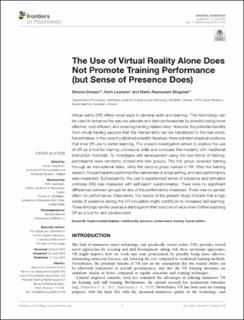| dc.contributor.author | Grassini, Simone | |
| dc.contributor.author | Laumann, Karin | |
| dc.contributor.author | Skogstad, Martin Rasmussen | |
| dc.date.accessioned | 2020-09-08T10:49:23Z | |
| dc.date.available | 2020-09-08T10:49:23Z | |
| dc.date.created | 2020-07-29T14:45:35Z | |
| dc.date.issued | 2020 | |
| dc.identifier.citation | Frontiers in Psychology. 2020, 11 . | en_US |
| dc.identifier.issn | 1664-1078 | |
| dc.identifier.uri | https://hdl.handle.net/11250/2676838 | |
| dc.description.abstract | Virtual reality (VR) offers novel ways to develop skills and learning. This technology can be used to enhance the way we educate and train professionals by possibly being more effective, cost-efficient, and reducing training-related risks. However, the potential benefits from virtual training assume that the trained skills can be transferred to the real world. Nevertheless, in the current published scientific literature, there is limited empirical evidence that links VR use to better learning. The present investigation aimed to explore the use of VR as a tool for training procedural skills and compare this modality with traditional instruction methods. To investigate skill development using the two forms of training, participants were randomly divided into two groups. The first group received training through an instructional video, while the second group trained in VR. After the training session, the participants performed the trained task in a real setting, and task performance was measured. Subsequently, the user’s experienced sense of presence and simulator sickness (SS) was measured with self-report questionnaires. There were no significant differences between groups for any of the performance measures. There was no gender effect on performance. Importantly, the results of the present study indicate that a high sense of presence during the VR simulation might contribute to increased skill learning. These findings can be used as a starting point that could be of value when further exploring VR as a tool for skill development. | en_US |
| dc.language.iso | eng | en_US |
| dc.publisher | Frontiers Media | en_US |
| dc.rights | Navngivelse 4.0 Internasjonal | * |
| dc.rights.uri | http://creativecommons.org/licenses/by/4.0/deed.no | * |
| dc.title | The Use of Virtual Reality Alone Does Not Promote Training Performance (but Sense of Presence Does) | en_US |
| dc.type | Peer reviewed | en_US |
| dc.type | Journal article | en_US |
| dc.description.version | publishedVersion | en_US |
| dc.source.pagenumber | 11 | en_US |
| dc.source.volume | 11 | en_US |
| dc.source.journal | Frontiers in Psychology | en_US |
| dc.identifier.doi | https://doi.org/10.3389/fpsyg.2020.01743 | |
| dc.identifier.cristin | 1820942 | |
| dc.description.localcode | Copyright © 2020 Grassini, Laumann and Rasmussen Skogstad. This is an open-access article distributed under the terms of the Creative Commons Attribution License (CC BY). The use, distribution or reproduction in other forums is permitted, provided the original author(s) and the copyright owner(s) are credited and that the original publication in this journal is cited, in accordance with accepted academic practice. No use, distribution or reproduction is permitted which does not comply with these terms. | en_US |
| cristin.ispublished | true | |
| cristin.fulltext | original | |
| cristin.qualitycode | 2 | |

